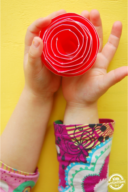Let’s do an egg shell squeeze science experiment today! Have you ever thought about how strong an egg shell is? Most of the time we think of eggs as being fragile and breakable. Let’s take a little deeper look at which is right…is an egg shell fragile or is it strong? This simple kids science experiment explores the wonders of the egg shell and how it can be strong and weak at the same time.

Egg Shell Science Experiments For Kids
About Egg Shells
The function of the eggshell is to protect the embryo from the environment, but it cannot be too strong otherwise the chick would not be able to break out and hatch. It is made of calcium carbonate, an important biomineral, which is different from hydroxyapatite, the mineral component of bone.
Egg Shells are Strong and Fragile at Same Time
That means an egg shell needs to be really strong to protect the future hatching chick, but not too strong that the chick cannot get out of the shell. One of the ways that this is possible is through the egg shell science that we are about to explore…
Knowing how easy an egg cracks, it makes sense to think they are fragile. But they are extremely strong – so strong that you can squeeze an egg in these simple experiments and never break it’s shell.
Note: We recommend doing this set of kitchen science food experiments in the backyard or over the kitchen sink!
Egg Shell Strength Squeeze Test #1

First, place an egg in the palm of your hand. Close your hand so that your fingers are completely wrapped around the egg. Squeeze the egg by applying even pressure all around the shell. I was nervous to try this and stood over my kitchen sink. You can too. Did the shell break?
No. Amazing, right?
Egg Shell Strength Squeeze Test #2

Try another way – Hold the egg between your thumb and forefinger and squeeze the top and bottom of the egg. Did it break when you squeezed it this way?
Egg Shell Strength Squeeze Test #3

Finally, hold the egg in the palm of your hand. Press only on one side of the shell. Do not squeeze the egg – just press on the side.
What happens? Why do you think this happens?
Science Behind Egg Shell Strength
The Strong Shell: The egg’s unique shape gives it tremendous strength, despite its fragility. Think of an egg as a 3-dimensional arch. The egg is strongest at the top and the bottom. That’s why the egg doesn’t break when you add pressure to both ends like in our 2nd science experiment.
When you hold the egg in your hand and squeeze, you are distributing pressure all over the egg like in the first science experiment. The curved shell can distribute this pressure rather than concentrating it all on one area. When an egg is cracked on the side of a bowl, it breaks as the pressure is concentrated on one side.
This also explains how a hen can sit on an egg and not break it, but a tiny little chick can break through the eggshell – the weight of the hen is evenly distributed over the egg, while the pecking of the chick is an uneven force directed at just one spot on the egg.
What are some other easy eggshell science projects for kids?
Here are a few easy eggshell science projects that are suitable for kids.
Don’t forget the scientific method as your kids complete their eggshell science experiments. Grab free printable worksheets outlining the scientific method to use with your kids!
Eggshell Dissolving Experiment:
Materials needed: Eggshells, vinegar, clear cups or containers
Procedure: Gently place eggshells in separate cups or containers. Pour vinegar over the eggshells until they are fully submerged. Observe and record changes in the eggshells over time. Note any bubbling or fizzing, and measure how long it takes for the eggshell to dissolve completely.
Explanation: Vinegar is an acid that reacts with the calcium carbonate in the eggshell, causing it to dissolve. This experiment demonstrates the process of chemical erosion.
Eggshell Strength Test:
Materials needed: Eggshells, books or weights of different sizes, ruler or measuring tape
Procedure: Carefully place an eggshell on a flat surface. Gradually place books or weights on top of the eggshell until it cracks. Measure and record the weight or number of books required to crack the eggshell. Repeat the process with different weights or sizes of books.
Explanation: This experiment helps determine the strength of an eggshell. The more weight or pressure required to crack the eggshell, the stronger it is.
Eggshell as a Seed Starter:
Materials needed: Eggshells, potting soil, seeds, egg carton or tray
Procedure: Clean and dry eggshells, leaving a portion intact. Fill each eggshell with potting soil and plant a seed inside. Place the eggshells in an egg carton or tray, ensuring they stand upright. Water the eggshells regularly and observe seed germination and growth.
Explanation: Eggshells can be used as biodegradable seed starters. The eggshell provides nutrients like calcium to the growing seedling, and it can be planted directly into the soil once the seedling is ready.
Does an eggshell science project teach STEM to my kids?
The eggshell squeeze test teaches kids several STEM (Science, Technology, Engineering, and Mathematics) concepts:
- Force and Pressure: When kids squeeze an eggshell, they learn about force and how it applies pressure to the shell. They can see that applying more force or pressure can cause the shell to crack or break.
- Strength and Structure: By comparing different eggshells and observing their resistance to breaking, kids understand that materials have different levels of strength. They learn that the thickness and composition of the shell affect its strength.
- Material Properties: Kids learn that different materials, like eggshells, have specific properties. They compare the eggshell’s characteristics to other materials, such as wood, plastic, or metal, and understand that materials behave differently based on their properties.
- Engineering Design: Have you ever done the egg drop science project? Create a structure that allows you to drop an egg from a set height without the eggshell breaking. Can you do it?
- Scientific Method and Data Analysis: Kids can follow the scientific method while conducting the eggshell squeeze test. They form a hypothesis, perform the experiment with controlled variables, record their observations, and analyze the data collected. This teaches them the importance of data analysis and drawing conclusions based on evidence.
How strong are eggshells?
Eggshells make a great science project because they may seem delicate, but they actually possess surprising strength. They are designed to protect the developing embryo inside the egg, so they have some resilience.
The strength of eggshells can vary depending on factors like their thickness, the type of animal they come from, and the conditions in which they were formed. While eggshells aren’t as strong as materials like metal or wood, they can withstand a certain amount of force before breaking or cracking. It’s important to handle them with care, as they are still fragile.
If you’re interested in learning more about the mechanical properties of eggshells, you can check out this article from the Exploratorium, a reputable science museum: “The Incredible Eggshell.”
More Science Fun from Kids Activities Blog
This egg shell squeeze experiment is amazing. We have more food science ideas for your child to explore. For more kids activities like these, please take a look at some of these ideas:
- A really good next science experiment for kids to follow this egg shell strength test would be our egg in vinegar experiment which lets kids see egg shells in a whole new way!
- More food science learning with our rotten pumpkin experiment…this is creepy fun!
- Another fun science experiments using eggs is can you tell a raw egg vs cooked egg without breaking the egg shell?
- Have you ever wondered can you hatch store bought eggs?
- Did you know you could scramble an egg inside the shell?
- You can make the traditional egg yolk paint with this simple recipe just like the masters used to!
- Need the best egg drop design for the science fair? We have good solid egg drop ideas.
- Have you ever wondered about a cashew shell? Why aren’t they sold inside the shells?
- Find out what happens if you drop a penny from the top of the Empire State Building.
- Here are some fun dr seuss science activities!
- Or these fun summer science experiments!
- Here are some fun bacteria experiment ideas!
- Learn about force, friction, and motion with this tug of war science lesson.
- We have a simple surface tension experiment!
What do you think now? Is an egg shell strong or fragile? What happened in your egg squeeze experiment?




















Wow! This could be one particular of the most beneficial blogs We’ve ever arrive across on this subject. Actually Great. I am also a specialist in this topic therefore I can understand your effort.
This is a great explanation! I think I’ll do this experiment next time we cook 🙂